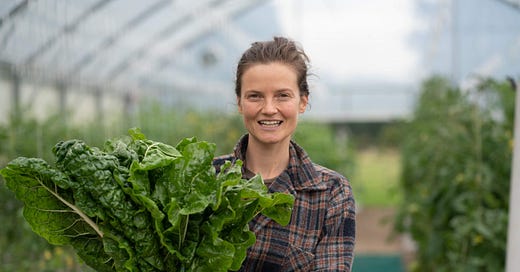Why we should all eat Silverbeet
#EatNZKaitaki Lydia Thomsen is a nutritionist, food grower & owner of Pickled Compost. She shares how the reliable nature of silverbeet makes it ideal to grow & consume to diversify our diet & planet.
While I realise this may come across as a gentle nutritionist nudge to make sure you are eating your greens, I did want to make this more of an appreciation post for our much loved Silverbeet (Kōrare) or Beta vulgaris.
What is well known as Chard or Swiss Chard in other parts of the world - here in Aotearoa New Zealand (and Australia) the Fordhook Giant variety, most commonly found in people’s backyards is what we proudly claim as ‘Silverbeet’.
Since I started market gardening, silverbeet has been the most reliable, low-maintenance and productive leafy green I have had the pleasure of tending to. Its tall, prominent white stalks and its big dark-green crinkly leaves take on a silvery sheen in full sun, which is especially joyous when there’s nothing else going on in the garden. It is also a reassuring feeling knowing how versatile this green is, that you can add it to just about any meal.
As a biennial, (flowers and seeds in the second year), it’s one of the highest-yielding crops you can grow and can be grown all year round in New Zealand due to our relatively mild winters. This means its quality leafy goodness is available for at least 12 months and if well tended can even be as long as two years! It also means they can maintain a relatively long-term living root system compared to other leafy green vegetables, which is always a win for encouraging biodiversity in the soil.
Silverbeet has been revered across the Mediterranean for centuries. A close relative to the beetroot, silverbeet was cultivated from the sea beet for its foliage from as far back as the 4th Century BC. The Greeks were the first to adopt it into their cuisine, where the cherished leaves are to this day commonly included with Greek cheese to make spanakopita (spinach pie). Interestingly, Italians regard the stalk more highly in their dishes. The stalk is removed from the leaf blade and prepared separately and can be cooked into a puree with nutmeg and cream or fried in olive oil to be added to a healthful bowl of minestrone soup.
In New Zealand, silverbeet only became common on our plates during the 1940s, but soon became a mainstay green (and often boiled to smithereens might I add) when the traditional meal formula of ‘meat and three veg’ was followed. Fortunately my Mum knew better and would par-boil silverbeet; squeezing lemon juice afterwards to increase its flavour and nutrient availability, while also adding the trusty nutmeg to bring out the ‘earthiness’ of the leafy green.
Nowadays with the rise in popularity of other in-trend greens such as baby spinach and Tuscan kale, you could argue that perhaps silverbeet has lost some of its shiny appeal… Just as well I’m here to tell you not to give up on this gem of a green just yet!
Silverbeet is just as highly nutritious as the likes of spinach and kale, in some respects packed with more nutrients - such as Vitamin A, K and folate than its kale counterpart. However, it’s important to note that eating a variety of green leafy vegetables (which includes silverbeet, chard, spinach, kale, cabbage etc.) is always key to getting all the necessary nutrients, vitamins and minerals to maintain a healthy diet. The thing is, it’s important NOT to boil the life out of this poor plant. Not only do you destroy the flavour profile but you lose essential nutrients in the process. Instead, silverbeet can be enjoyed steamed, gently fried with garlic and chilli or added to dishes such as pasta or curries.
Plus because silverbeet is generally always available, it becomes an inexpensive green to opt for if you don’t have it growing in your garden. There are also a number of colourful varieties to choose from these days with stalks ranging from deep pink, orange, yellow and red - appropriately referred to as Rainbow Chard. Yes, any opportunity to encourage eating the rainbow!
The versatility that silverbeet brings to New Zealand cuisine makes it a star performer in the world of homegrown veggies. Because silverbeet has always been a relatively easy crop to grow, is highly productive and cheaper than other more fashionable greens, I believe it is one of the most accessible and nutritious edible leafy vegetables we can include to ensure we are prioritising diversity in our diets.
I also hope this means there’s no excuse to not eat your greens. :)
See more from Lydia over on Instagram @agreeablegrub / @mangaroafarms / @pickledcompost.
This is a post in collaboration with #FOODDIVERSITYDAY taking place on Jan 13th in the UK. Learn more here.





I am going to bring silverbeet back into my diet. I like the cooking suggestions and I will also try silverbeet with pasta - which I had always thought you could only use spinach in pasta.
I will also try the other suggestions adding garlic / nutmeg.
Thanks for this article 😄